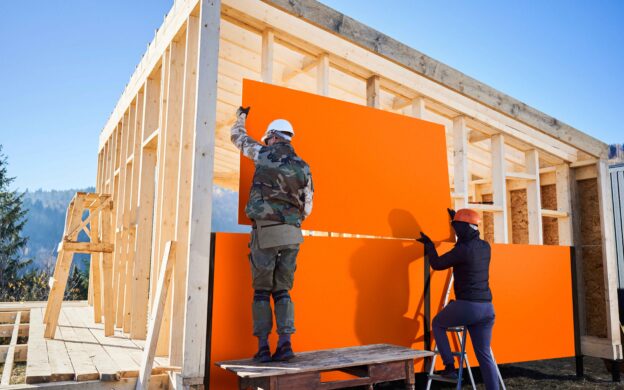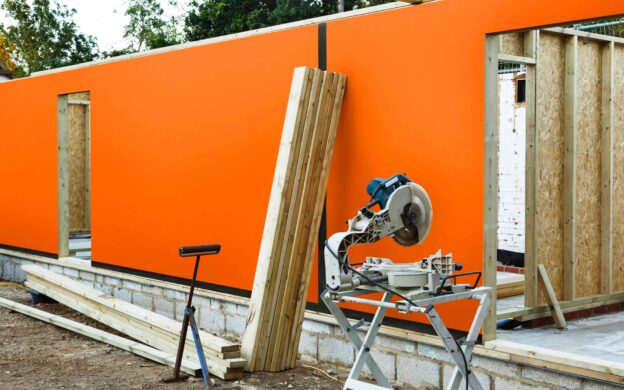
Set in 2019, that target shows no signs of being met. Post-pandemic housebuilding rates have yet to match the levels achieved in 2019-20, when nearly a quarter of a million ‘net additional dwellings’ were constructed.
Modern methods of construction (MMC) have long been championed as a solution to this housebuilding crisis. Modular housing systems and offsite construction processes promise to speed up the construction process while also delivering better quality and performance. And yet, 2023 has been a difficult year for the sector, with bad press around high-profile manufacturers closing factories.
All of this begs the question: will the UK ever fully embrace offsite and modular housebuilding, and enjoy the benefits of the promised revolution?
What has happened to modular housebuilding in the UK in 2023?
A number of manufacturing operations ceased production in 2023, denting confidence in the sector. While there are internal and external factors specific to each case, broadly the challenges can be categorised in terms of organisations taking on a lot of risk and operating at a loss for years.
The risks assumed by organisations are multi-faceted. They invest in substantial production facilities, while the level of demand remains relatively low. Delivering housing sites at the anticipated rate is also a challenge when delays occur while purchasing land and negotiating the planning system.
Modern modular housing must also combat perceptions formed during previous attempts to deliver modular, ‘prefab’ housing – a situation not dissimilar to the challenges faced in the timber framed housing sector, which has a good deal of overlap with offsite housing.
However, as an article in ‘Inside Housing’ makes clear, there is still a compelling case for MMC when it comes to housebuilding. Current problems in MMC-delivered housebuilding do not mean that MMC itself has an uncertain future, or that large volumes of homes cannot be delivered via that route.
Why is 300,000 homes a year such an important figure?
The government’s commitment to a certain level of housebuilding has become a much-quoted figure. It is an attention-grabbing target, both as a nice round number, and because it requires more than a 20% increase over current housebuilding rates to be met.
And the longer that the figure fails to be met, the more notorious it becomes as a target – especially as more and more people struggle to gain a foothold on the property ladder.
The ambition was for the figure of 300,000 homes to be met, and maintained, by the mid-2020s, but as we enter 2024 current rates are around 235,000 a year. The government has also been unsuccessful in changing planning laws to impose minimum housing numbers on local areas – something that was seen as key to helping achieve the target but which was met with opposition.

Can a ‘timber in construction’ roadmap help to unlock more offsite housing?
December 2023 saw the government publish a roadmap aimed at increasing the supply of homegrown timber (around 80% of timber used in the UK is imported). A key use for it would be in the construction of buildings, including housing.
As part of promoting the safe and sustainable use of timber as a construction material, the UK government has committed to “supporting the use of MMC to deliver quality homes more quickly”. MMC is seen as a ‘key enabler’ for using resources more efficiently across the building life cycle. The government therefore also plans to “assess options and explore opportunities for scaling innovations in housing construction using English timber by 2025.”
The timber frame market is already growing in the UK. The construction method accounts for some 85% of the new-build housing market in Scotland. Increasing the proportion of timber framed housing in England and Wales is a significant opportunity, and a 2022 report suggested the market could grow by as much as £150 million by 2026.
The speed and quality that is possible when using timber frame cassettes or SIP panels can deliver more houses sooner, even before the effects of this roadmap are seen.
Using Arctek® Dryshell™ to help deliver more timber framed housebuilding
For the timber frame and offsite/modular sectors to deliver warm, comfortable and healthy homes that can be constructed quickly and cost effectively, requires new approaches. That’s why Arclin created Arctek® Dryshell™, an integrated vapour-permeable overlay for OSB sheathing boards.
The overlay provides high levels of performance and helps to achieve faster on-site delivery of homes compared to the tedious and labour-intensive installation of housewrap products. It is a continuous and factory-applied solution that ‘fuses’ to OSB, allowing it to be used in both on-site and offsite construction methods.
Timber framed housebuilding solutions with Arctek® Dryshell™ arrive on site with the layer already in place, removing an installation step to save time and reduce labour costs, when compared to housewrap installations. With Arctek® Dryshell™ a simple taping between panel seams is all that is required. The overlay offers moisture-resistance and vapour-permeability with improved airtightness. And with no tricky installation details usually associated with more traditional housewraps, there is no risk of rips or tears, so no moisture or dirt can get into the construction.
Arctek® Dryshell™ helps timber framed housing manufacturers and suppliers to make improvements to their processes and take greater advantage of the growing timber frame market in the UK. To find out more about how Arctek® Dryshell™ can benefit your timber framed housebuilding projects, request a sample or contact us with an enquiry.


